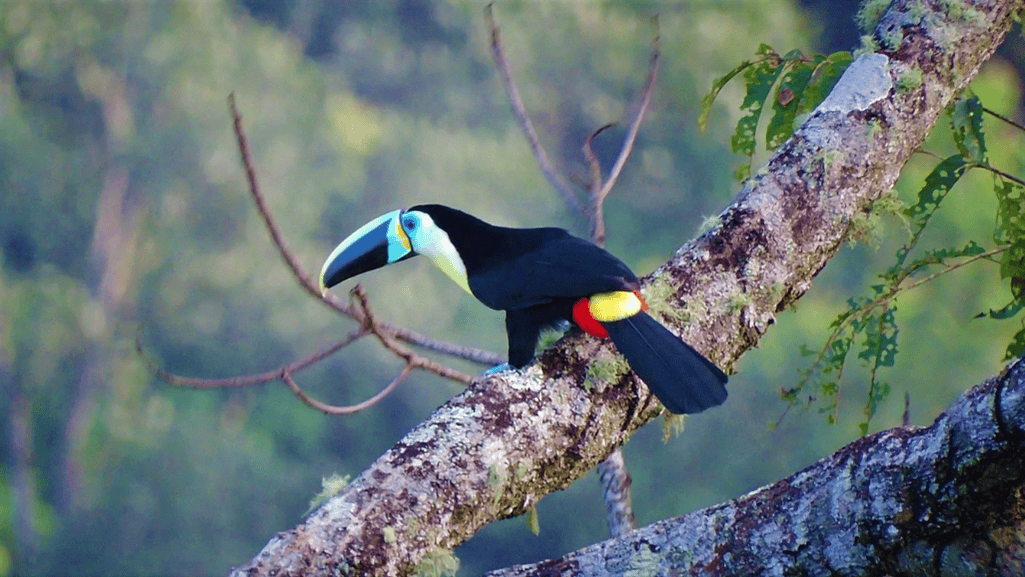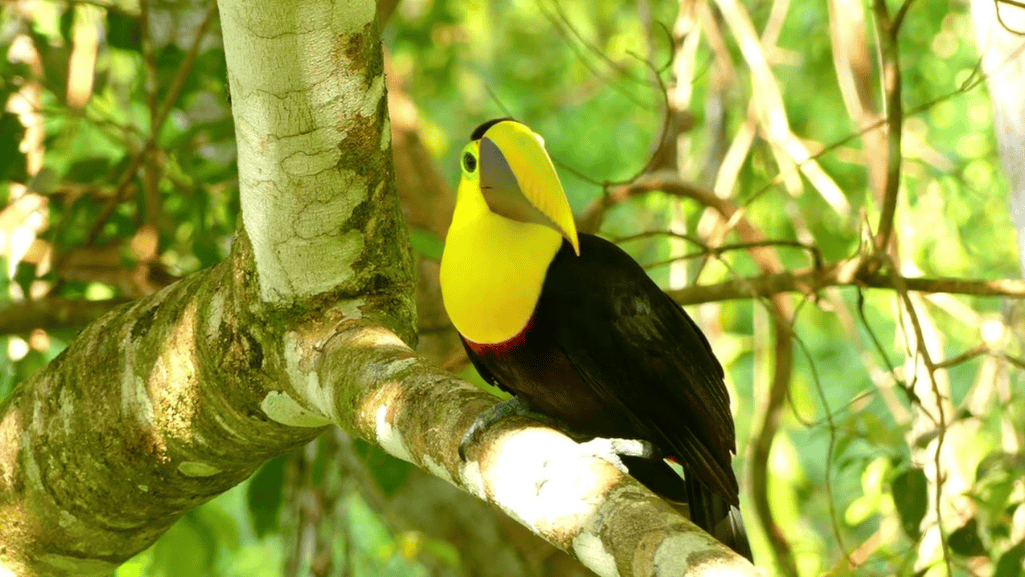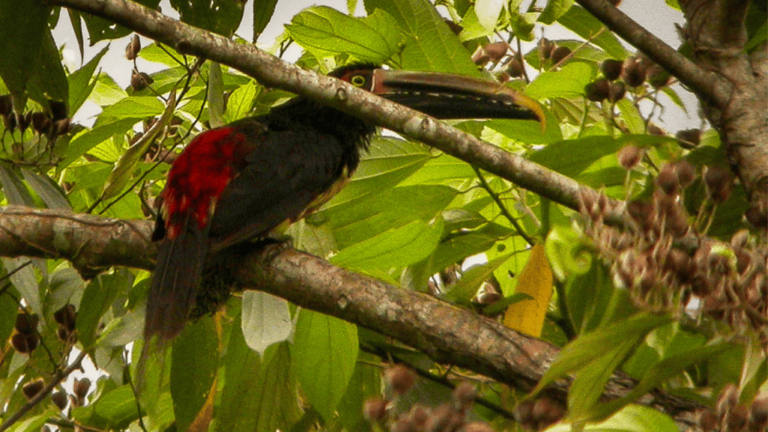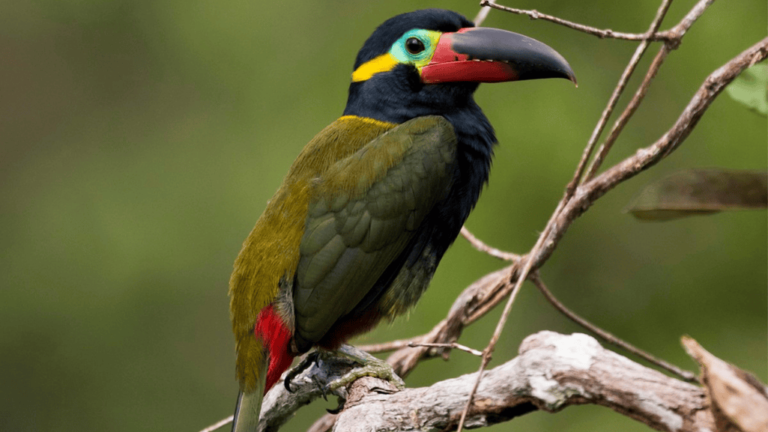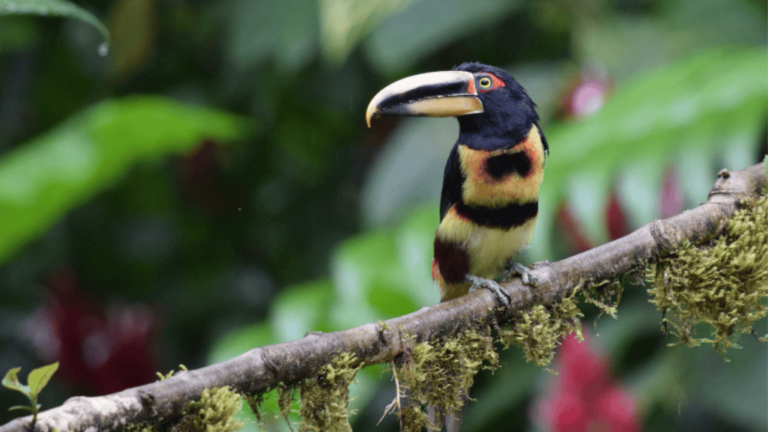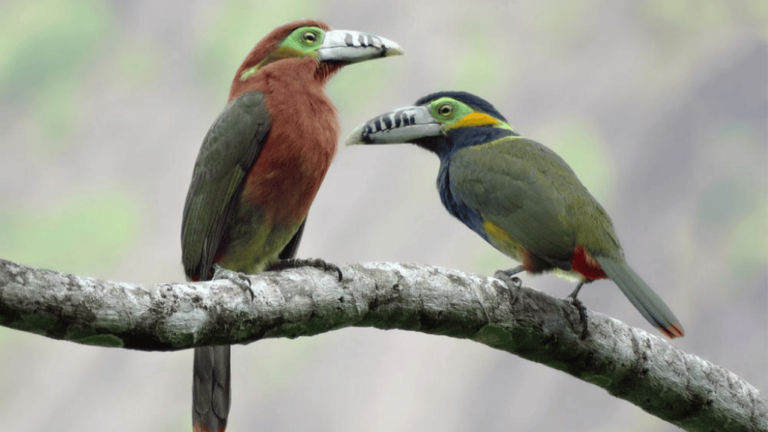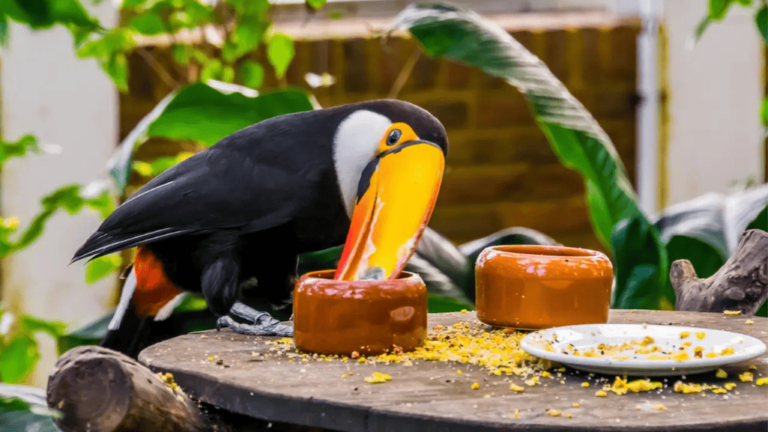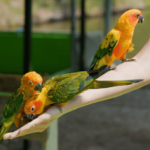The Citron-throated Toucan, scientifically known as Ramphastos citreolaemus, is a colorful toucan bird species found in Colombia and Venezuela. It is a wildlife species that belongs to the family Ramphastidae, which also includes toucanets and aracaris. Known for its vibrant appearance, the Citron-throated Toucan has a black plumage with pale lemon yellow feathers on its throat, breast, and rump, adorned with a red band below the breast. Its large, black bill is a distinctive feature, complemented by a blue-green base and a yellow patch.
This tropical bird measures about 48 cm (19 in) in length and weighs around 360 g (13 oz). It is mainly found in mature humid forests in lowland and foothill areas. The Citron-throated Toucan primarily feeds on fruits, but it also consumes a range of prey including insects, arthropods, lizards, and even other birds and their eggs. Currently, this toucan species is not classified as threatened and is considered a year-round resident in its habitats.
Key Takeaways:
- The Citron-throated Toucan is a colorful toucan bird species found in Colombia and Venezuela.
- It has a distinctive appearance with a black plumage, yellow and red accents on its feathers, and a large, black bill.
- The toucan primarily feeds on fruits but also consumes insects, arthropods, lizards, and other birds.
- Its habitat includes mature humid forests in lowland and foothill areas.
- The Citron-throated Toucan is not currently classified as a threatened species.
Taxonomy and Description
The Citron-throated Toucan is classified as a subspecies of the channel-billed toucan (Ramphastos vitellinus) by some taxonomical systems while others treat it as a separate species. It is monotypic, meaning that there are no recognized subspecies within the Citron-throated Toucan.
The bird is known for its vibrant coloration, with a black plumage, yellow and red accents on its feathers, and blue skin around its eyes. The bill of the Citron-throated Toucan is long and black, with a narrow greenish-yellow culmen, a wide yellow band at the base of the maxilla, and a blue-green base to the mandible.
Both male and female Citron-throated Toucans have similar appearances. They typically measure about 48 cm (19 in) in length and weigh around 360 g (13 oz).
At a Glance: Citron-throated Toucan Description
Let’s summarize the key features and characteristics of the Citron-throated Toucan:
- Scientific name: Ramphastos citreolaemus
- Classification: Subspecies of Ramphastos vitellinus or separate species
- Coloration: Black plumage with yellow and red accents on feathers
- Eye color: Blue skin around the eyes
- Bill: Long and black with a narrow greenish-yellow culmen
- Bill base: Wide yellow band on the maxilla and blue-green base on the mandible
- Size: Approximately 48 cm (19 in) in length
- Weight: Around 360 g (13 oz)
Distribution and Habitat
The Citron-throated Toucan is primarily found in northern Colombia and northwestern Venezuela. It inhabits mature humid forests in lowland and foothill areas. The bird can be found at elevations up to 500 m (1,600 ft) in Venezuela and 900 m (3,000 ft) in Colombia. Its habitat preference includes areas with a rich diversity of flora, allowing for a variety of fruit sources. The toucan’s range extends from sea level to higher elevations, where it relies on moist and lush forest environments for food and nesting sites. However, the Citron-throated Toucan has been observed on the outskirts of forested areas, including tropical savannas, as long as water sources are nearby.
Behavior and Feeding Habits
The Citron-throated Toucan is an arboreal species that spends most of its time in the forest canopy. With its acrobatic movements and agility, it effortlessly navigates the treetops, showcasing its remarkable behavior. As a non-migratory bird, the Citron-throated Toucan remains a year-round resident within its range.
While the toucan is often seen alone or in pairs, it may also join mixed-species flocks for feeding, enabling it to interact with other bird species in its habitat. This behavior not only allows the toucan to find safety in numbers but also provides opportunities for socializing and learning from other birds in the group.
The Citron-throated Toucan has a highly varied diet, with fruits comprising its primary food source. Its fruit diet includes a wide assortment of fruits found in its habitat, providing both sustenance and nutritional diversity. From the mid-storey to the canopy, the toucan utilizes its large bill to pluck fruits from branches, displaying its specialized foraging habits.
In addition to fruits, the Citron-throated Toucan supplements its diet with a range of other food items. It opportunistically feeds on insects, arthropods, lizards, and even other birds and their eggs when available. This flexible feeding behavior allows the toucan to adapt to varying food availability in its environment.
The unique bill structure of the Citron-throated Toucan plays a vital role in its feeding habits. With its long and powerful bill, the toucan is well-equipped for grasping and manipulating fruits and capturing other prey items. Additionally, the toucan’s long feather-like tongue with bristles on the sides assists in catching and consuming its food, further enhancing its feeding capabilities.
In summary, the Citron-throated Toucan’s behavior encompasses its preference for arboreal habitats, its social interactions with other bird species, and its specialized foraging habits. Its varied diet, primarily consisting of fruits, supplemented by insects and other small prey, showcases the adaptability and resourcefulness of this remarkable tropical bird.
| Feeding Habits | Diet |
|---|---|
| Primary Food Source | Fruits |
| Additional Food Sources | Insects, arthropods, lizards, and other birds and their eggs |
| Foraging Range | Mid-storey to canopy |
| Feeding Behavior | Plucking fruits with large bill, capturing prey with specialized tongue |
Conservation Status
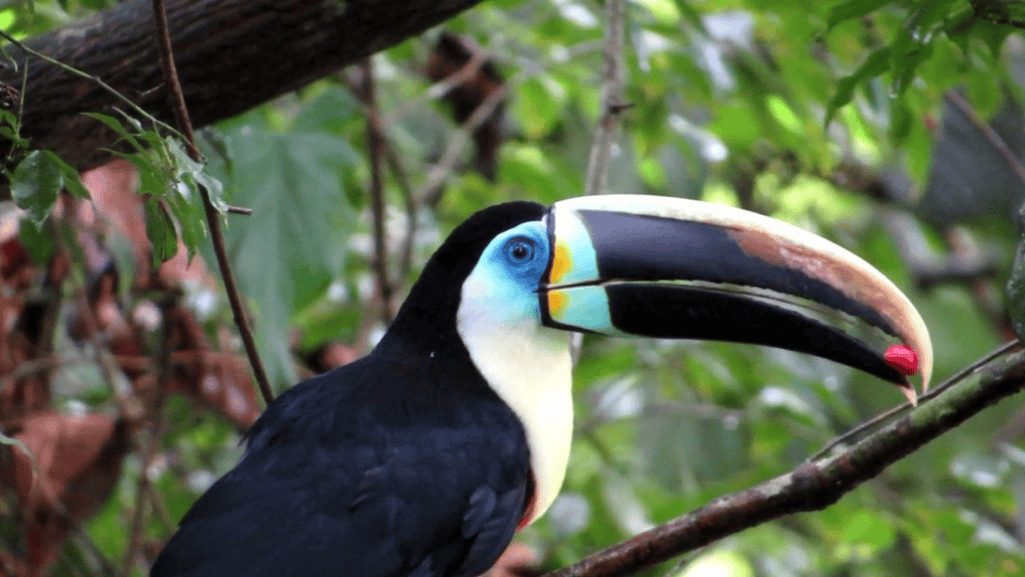 The Citron-throated Toucan, known scientifically as Ramphastos citreolaemus, is currently classified as Least Concern by the International Union for Conservation of Nature (IUCN). Despite its large range and lack of immediate threats, the species’ population is believed to be experiencing a decline.
The Citron-throated Toucan, known scientifically as Ramphastos citreolaemus, is currently classified as Least Concern by the International Union for Conservation of Nature (IUCN). Despite its large range and lack of immediate threats, the species’ population is believed to be experiencing a decline.
Habitat loss poses the greatest threat to the Citron-throated Toucan. Deforestation, along with human activities like agriculture and urbanization, has resulted in the loss of its natural habitat. In Colombia, the toucan is considered uncommon, but it can still be found in several protected areas. However, in Venezuela, particularly around the Lake Maracaibo basin, the toucan’s foothill habitat is rapidly disappearing, making it increasingly scarce and localized to that region.
Efforts are underway to promote the conservation of the Citron-throated Toucan and protect its remaining habitats. These actions aim to counteract the population decline caused by habitat loss, ensuring the long-term survival of this unique and colorful toucan species.
FAQ
What is a Citron-throated Toucan?
The Citron-throated Toucan, scientifically known as Ramphastos citreolaemus, is a colorful toucan bird species found in Colombia and Venezuela. It has a black plumage, a narrow greenish-yellow culmen, and pale lemon yellow feathers on its rump, throat, and breast, adorned with a red band below the breast. It has a large, black bill with a blue-green base and a yellow patch.
Where can the Citron-throated Toucan be found?
The Citron-throated Toucan is primarily found in northern Colombia and northwestern Venezuela. It inhabits mature humid forests in lowland and foothill areas, with elevations up to 500 m (1,600 ft) in Venezuela and 900 m (3,000 ft) in Colombia.
What does the Citron-throated Toucan eat?
The Citron-throated Toucan primarily feeds on fruits but also consumes insects, arthropods, lizards, and even other birds and their eggs. It forages from the mid-storey to the canopy, using its large bill to pluck fruits from branches.
Is the Citron-throated Toucan a threatened species?
Currently, the Citron-throated Toucan is not classified as a threatened species. However, its population size is unknown and believed to be decreasing due to habitat loss caused by deforestation and human activities such as agriculture and urbanization.
In the peaceful landscapes of the Bahamas and the Greater Antilles, the Key West Quail-Dove finds its home. Known as Geotrygon chrysia, this bird is a treasure among Florida birds. Though it doesn’t live in the Florida Keys anymore, it sometimes visits, adding beauty to the Key West wildlife. Bird watchers in bird watching Key West dream of seeing this rare bird in the tropical and dry forests, shrublands, and moist forests it loves.
Key Takeaways
- The Key West Quail-Dove is still common in the Caribbean, showing the area’s rich wildlife.
- Even though it’s not considered endangered, it has a rich history with the Florida Keys.
- Its varied diet and unique breeding habits help it adapt to different environments.
- Seeing this dove is rare but exciting, like at the Deering Estate in Miami.
- Photographing the Key West Quail-Dove is hard because it’s hard to find and lives in dense forests.
- Trying bird watching Key West might let you see this special dove, making it more thrilling.
- It’s important to understand and protect the homes of Florida birds like the Key West Quail-Dove for their future.
Exploring the Unique Characteristics of the Key West Quail-Dove
The Key West Quail-Dove is a standout among endangered birds. Its unique looks and sounds have drawn bird lovers. This bird’s story highlights the importance of ornithology Key West research.
Physical Description and Identification
This bird has a dark, rust-colored back and bronze-green sheen on its head and neck. It’s known for a white stripe on its face against its red feathers. Males are about 11 3/4 inches long and have a wingspan of 17 1/2 inches, making them a notable size among Key West birds.
Vocalization Patterns and Calls
The Key West Quail-Dove makes a beautiful “hooooooo” sound that gets louder. It also coos softly, saying “Whoe-whoe-oh-oh-oh.” These sounds help identify it in the woods. Researchers say these calls are key in mating and defending against predators.
Studies show the Vocalization patterns and physical characteristics of the Key West Quail-Dove make it special. It’s a key focus for scientists and conservationists.
Understanding the Key West Quail-Dove’s Distribution
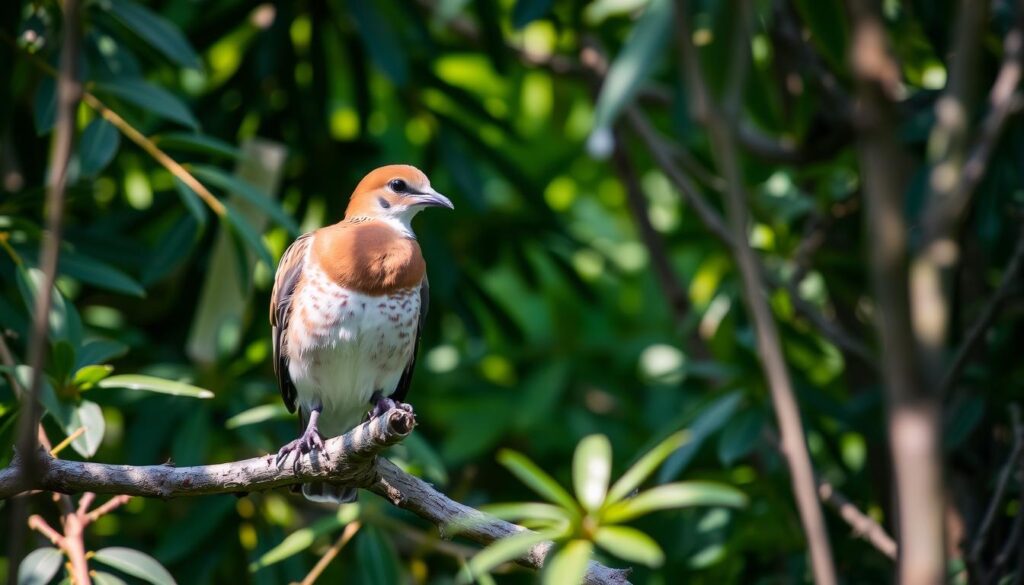
The Key West Quail-Dove is a symbol of tropical beauty, linked to the Caribbean’s lush landscapes. It lives in the Bahamas and the Greater Antilles. These places are key for bird watching destinations and bird conservation efforts.
These birds were once rare in Florida birds sightings, mainly in the southern parts of the state. The Florida Keys are famous for their wildlife and conservation efforts.
Habitats and Regions: From the Bahamas to the Greater Antilles
Key West Quail-Doves live in different habitats like dry forests and limestone areas. Their presence shows how rich and diverse their environments are. In Cuba, conservation projects help protect their habitats and many other bird species.
These birds can be found in places like New Providence and Cuba. Cuba is home to over 380 bird species and has 28 Important Bird Areas (IBAs). This makes it a key place for bird conservation efforts.
Studies show how the Key West Quail-Dove behaves and lives across its range. They sometimes appear in Florida during hurricanes or in mangrove forests during breeding season. This shows how they interact with their environments in unique ways.
Learning about the Key West Quail-Dove’s habits and habitats helps us understand Caribbean birds better. It also shows why working together is important for bird conservation. This knowledge helps protect bird watching destinations from environmental changes and human actions.
Threats to the Key West Quail-Dove’s Environment
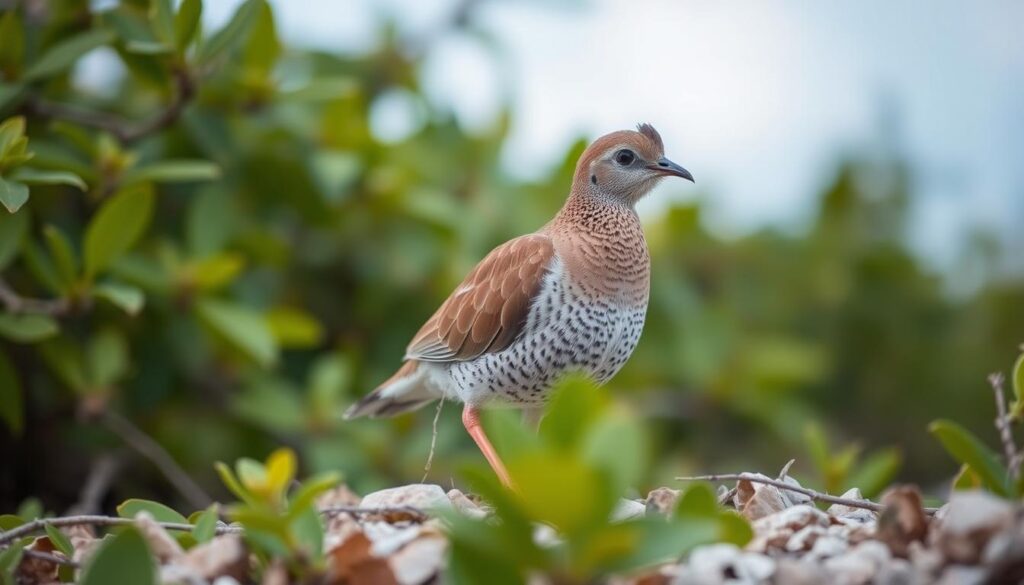
The Key West Quail-Dove needs urgent conservation due to environmental threats. It’s listed as Least Concern, but habitat loss and human impact are big problems. These threats can get worse if we don’t act fast.
Human Impact and Habitat Loss
Humans are harming the Key West by building more cities and farms. This destroys the homes of many endangered birds, including the Key West Quail-Dove. It also breaks up the land these birds need to survive.
Without enough land, these birds lose their food and places to nest. This makes it harder for them to live.
Conservation Status and Efforts
There are efforts to save the Key West Quail-Dove from these threats. These include fixing up habitats and making laws to protect them. One key step is the Federal Migratory Bird Special Purpose Game Bird permit.
| Permit Type | ePermit ID | Cost |
|---|---|---|
| Federal Migratory Bird Special Purpose Game Bird | 3-200-10e | $75 (non-refundable) |
Also, teaching people about birds and nature is crucial for conservation. By learning how important it is to protect wildlife, people can help. Together, we can make a safe place for the Key West Quail-Dove and other animals.
Key West Quail-Dove’s Diet and Foraging Behavior
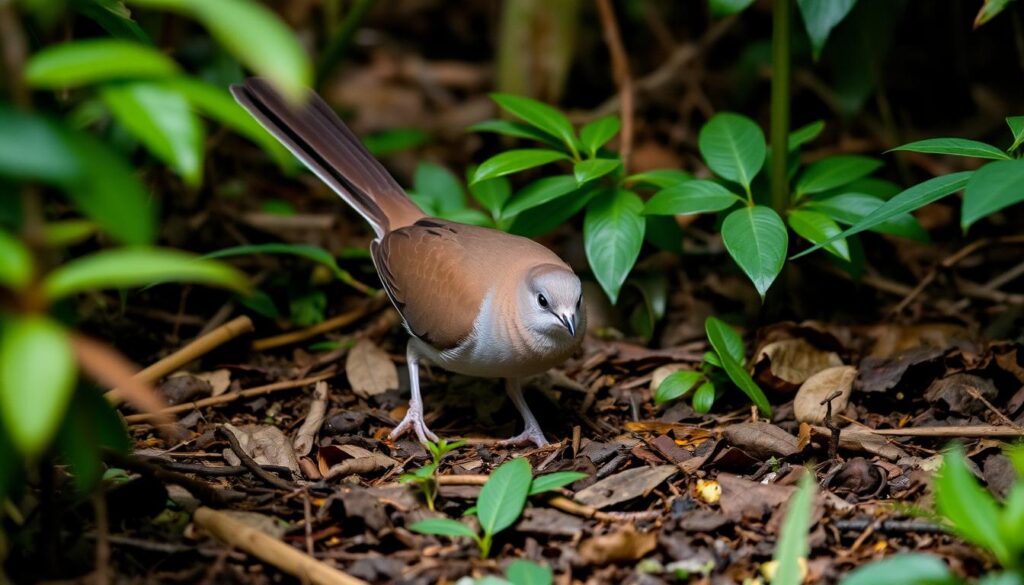
The Key West Quail-Dove is a unique bird species in Key West. It has a varied diet that shows how well it fits into its environment. Learning about their eating habits is interesting for bird lovers and helps with conservation.
Fruit and Seed Preferences
Key West Quail-Doves spend most of their time on the ground, looking for seeds, berries, and fruits. These foods make up most of what they eat. By eating these, they help spread seeds, which helps plants grow in Florida.
They especially like eating poisonwood fruit, which is common in their area. Eating poisonwood is important for their survival. It also helps with seed dispersal, which is key for their habitat.
The Importance of Poisonwood Fruit in Their Diet
Poisonwood fruit is a big part of the Key West Quail-Dove’s diet. Despite its name, it’s vital for the bird. It helps the bird and also spreads seeds, which is good for the environment.
Studies show that how these birds eat can tell us about the health of their environment. They pick up seeds and fruits, helping nature to heal and grow.
To learn more about the Quail Dove’s home and needs, check out options for creating safe outdoor spaces here.
| Fruit | Preference by Key West Quail-Dove |
|---|---|
| Poisonwood | Highly Preferred |
| Guazuma parvifolia | Moderately Preferred |
| Hamelia patens | Moderately Preferred |
| Ficus havanensis | Avoided |
This table shows the different fruits that are key to the Key West Quail-Dove’s diet. It highlights their specific likes, which helps scientists understand their needs better.
Nesting Habits of the Key West Quail-Dove
The Key West Quail-Dove is a key species in Florida birds. Its nesting habits are vital for bird conservation. Knowing these habits helps protect these unique birds.
Nest Construction and Egg-Laying
The Key West Quail-Dove builds a fragile platform for its nest. It’s usually in dense thickets or low in small trees. This helps protect their eggs and young. They lay two eggs that match their surroundings, helping them hide from predators.
Parental Roles and Chick Rearing
Both parents take turns caring for their eggs during the 12-day incubation. After hatching, the chicks depend on their parents for food and safety. This teamwork is key to their survival.
Studying the Key West Quail-Dove’s breeding and parenting helps us understand Florida birds better. It also highlights the importance of protecting their habitats. Resources like Java Sparrow bird conservation can inspire conservation efforts.
The Significance of Bird Watching Destinations for the Key West Quail-Dove
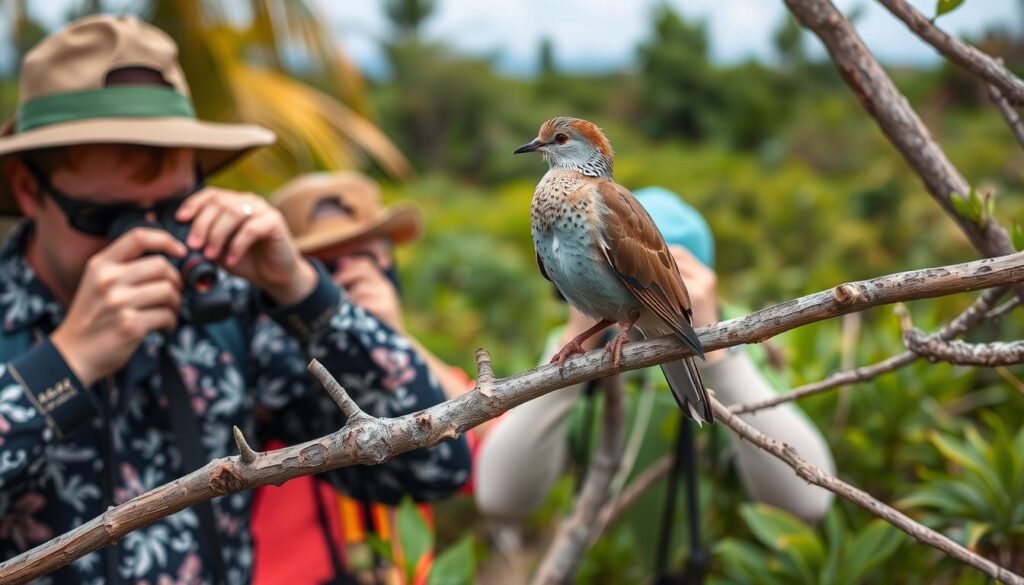
Key West is known for its lively Key West wildlife. It invites bird watchers from all over the world. The Key West Quail-Dove is a special bird that shows how rich the area is in wildlife. It also highlights the importance of bird watching in protecting nature.
This bird is known for its stunning looks, as John James Audubon once said. Bird watching in Key West brings joy to those who do it. It also helps the local environment and economy by supporting eco-tourism.
| Year | Event | Impact |
|---|---|---|
| 1832 | Audubon names the Key West Quail-Dove | Increase in initial interest and documentation |
| 2002 | Last sighting in South Florida | Highlighted rarity and urgent conservation need |
| Annual | Florida Keys Birding and Wildlife Festival | Attracts global birders, spotlighting Key West’s avian diversity |
Bird watching spots like Key West are key for research and learning. They bring together experts and bird lovers to study birds like the Key West Quail-Dove. This helps us understand how they move, live, and behave.
Visiting these places helps keep the interest in bird watching Key West alive. It also supports the work of saving their homes, which helps local conservation efforts.
Birding events like the Florida Keys Birding and Wildlife Festival make people more aware of these issues. They show off the beauty of the Key West Quail-Dove and talk about the big challenges birds face worldwide.
In short, Key West and its bird watching spots are crucial for saving the Key West Quail-Dove and other birds. Every time someone sees a bird, takes a photo, or visits, they help send a strong message. This message is about caring for our planet and working together to protect it.
Ornithology Key West: Studying Local Bird Species
In Key West, ornithology is more than a study; it’s a way to protect nature. The area is home to a wide variety of Florida birds. These birds make Key West a key spot for bird conservation efforts.
Scientists here study the local birds’ behaviors and how they live. They focus on species like the Key West Quail-Dove. This work is vital for protecting local and Florida’s ecosystems.
Research Contributions to Bird Conservation
Studies on the endangered White-fronted Quail-Dove show how changes affect them. Researchers in Key West gather important data. This helps make plans to save these birds and others.
The Role of Citizen Science in Bird Observation
Citizen science is key in Key West. Local people help by recording bird sightings and behaviors. This work adds to the science and connects people with nature.
This mix of professional research and community help is powerful. It helps protect birds and their homes. This approach is a model for bird conservation worldwide.
Key West Wildlife: Coexisting with the Key West Quail-Dove
In Key West, the Key West Quail-Dove is a key part of the local wildlife. It’s one of the many endangered bird species that make the area’s ecosystems rich and diverse. Andros Island, with its vast 6,000 km2, is a vital habitat for these birds, much like Florida’s own environments.
Despite having fewer than 10,000 people, Andros Island is seeing more development. This highlights the need for a balance that respects both human needs and the wildlife. The eastern coasts and northern islands are seeing more activity, which affects the Key West wildlife.
A study from April 24 to April 30, 2010, showed the importance of Andros’s pine forests and coppice. These forests, especially the old-growth ones in South Andros, are crucial for many species. However, fires and human actions have damaged much of the second-growth forests, which is a common issue for endangered birds.
It’s vital to monitor and conserve these forests to protect the Key West wildlife. This includes the endangered bird species that call these forests home.
Research on human development and bird populations is crucial. A study with 444 FeederWatchers in Florida showed how the Eurasian Collared-Dove has spread since its introduction in 1982. While these doves do well in areas changed by humans, native birds like the Key West Quail-Dove face a delicate balance.
This balance tells us a lot about our habitats and our responsibility to protect them. By working together, we can help ensure that many Florida birds will still be around for future generations. This will keep our skies beautiful and our ecosystems healthy.

